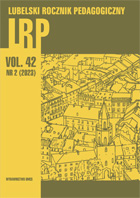SKALE OBSERWACYJNE DO OCENY ROZWOJU POZNAWCZEGO DLA OSÓB Z NIEPEŁNOSPRAWNOŚCIĄ INTELEKTUALNĄ W STOPNIU UMIARKOWANYM (KAPP_ SNIU), ZNACZNYM (KAPP_SNIZ) I GŁĘBOKIM (KAPP_SNIG) – CHARAKTERYSTYKA NARZĘDZIA
OBSERVATIONAL SCALES FOR ASSESSING COGNITIVE DEVELOPMENT OF PERSONS WITH MODERATE (KAPP_SNIU), SEVERE (KAPP_SNIZ) AND PROFOUND (KAPP_SNIG) INTELLECTUAL DISABILITIES – CHARACTERISTICS OF THE TOOL
Author(s): Beata Papuda-Dolińska, Anna Błaszczak, Katarzyna Wiejak, Tomasz Knopik, Grażyna Krasowicz-Kupis, Magdalena Łuniewska-Etenkowska, Piotr ZielińskiSubject(s): Individual Psychology, Applied Sociology
Published by: Wydawnictwo Naukowe Uniwersytetu Marii Curie-Sklodowskiej
Keywords: functional assessment; KAPP_S scales; intellectual disability; observational scales;
Summary/Abstract: Introduction: On the basis of education, the criterion-referenced diagnosis of the disorder does not provide sufficient grounds for planning educational and therapeutic support. The functional characteristics supplementing the data from the nosological diagnosis show the pos- sibilities and difficulties of a person in functioning in the everyday life context.Research Aim: The aim of the article is to present observational scales for assessing the cogniti- ve functioning of people with moderate (KAPP_SNIU), severe (KAPP_SNIZ) and profound (KAPP_SNIG) intellectual disabilities aged 6 to 25, which are part of the KAPP diagnostic battery. Evidence-based Facts: Current diagnostic instruments for the functional assessment of people with moderate, severe and profound intellectual disabilities contain outdated or non-standard- ized tools. In Poland, there is a need to supplement this catalogue.Summary: The scales are intended for functional assessment performed by special educators, psychologists and specialists. Theoretical assumptions on which the construction of the scales is based and the stages of this process, which included: pilot studies, standardization studies and validation studies, are presented. The psychometric properties of the scales as well as the data confirming convergent and differential validity are also described. The last chapter presenting the fields for interpretation of the results (inter-individual, intra-individual comparisons and be- tween the parallel perspectives of the parent and teacher in the 270-degree diagnosis model) gives specialists a picture of the possibility of using tools in everyday diagnostic and therapeutic work.
Journal: Lubelski Rocznik Pedagogiczny
- Issue Year: 42/2023
- Issue No: 2
- Page Range: 117-133
- Page Count: 17
- Language: Polish

